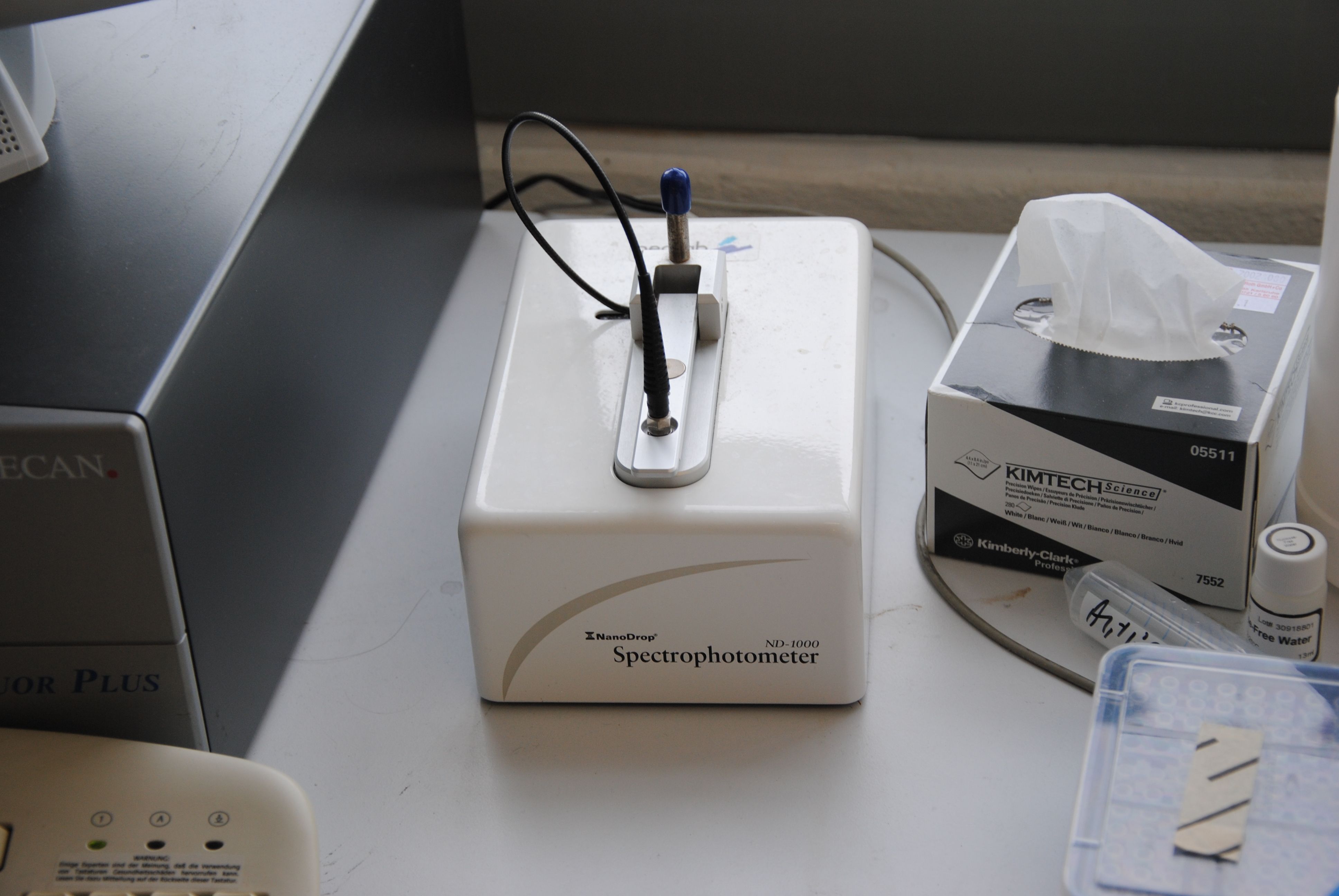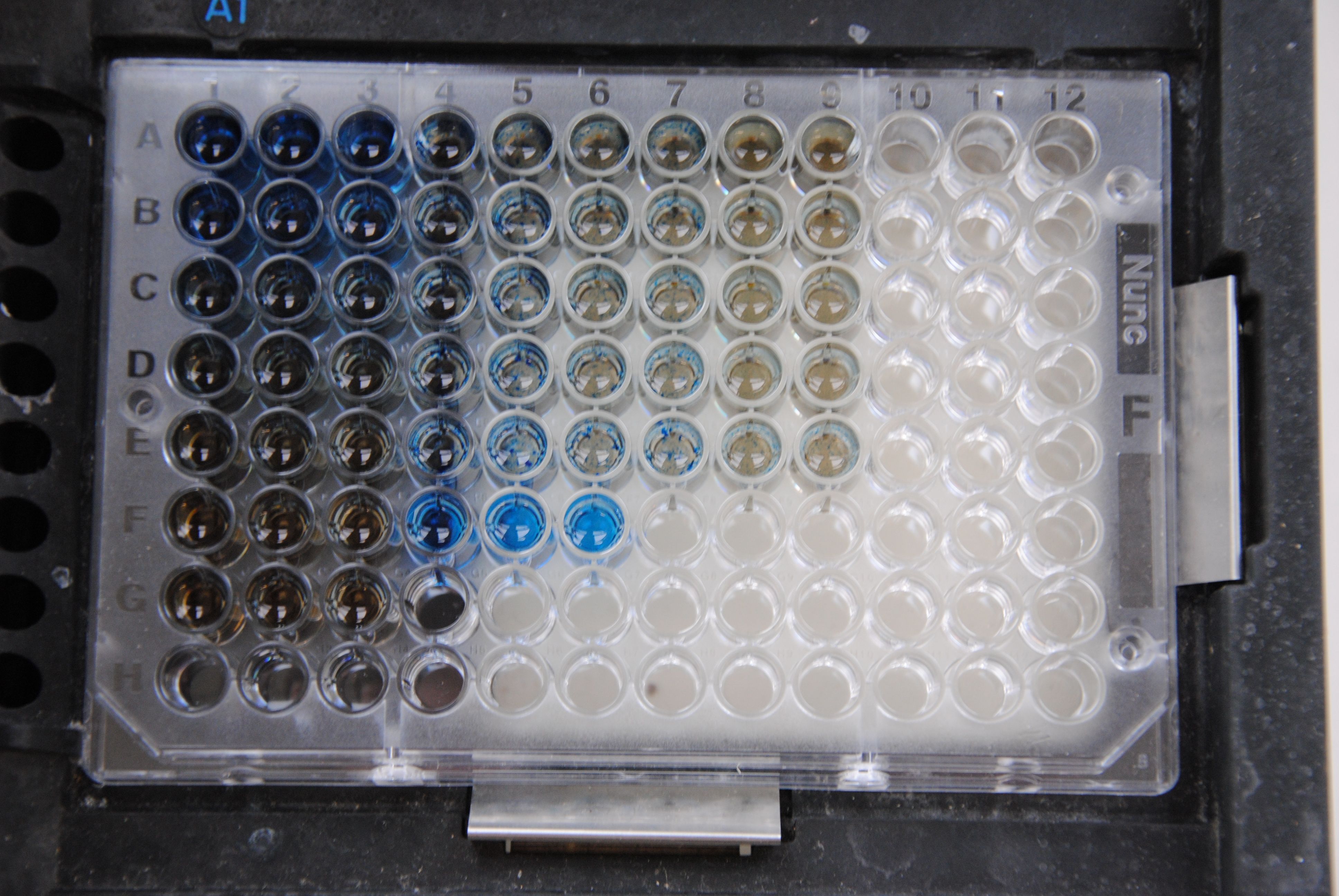Team:Bielefeld-Germany/Results/S-Layer/Guide/6
From 2011.igem.org
| Line 7: | Line 7: | ||
[http://lmgtfy.com/?q=his-tag Polyhistidine tags] are used for easy purification. They bind to Cobalt or Nickel ions which are normally immobilized on chromatography beads or in spin columns. We used a 1 mL HisTrap FF crude by [http://www.gehealthcare.com/ GE Healthcare] in combination with a [http://www.gelifesciences.com/aptrix/upp01077.nsf/Content/aktadesign_platform~akta_primeplus GE Healthcare ÄKTAprime™ plus] FPLC device or just with a syringe which is possible with [http://www.gelifesciences.com/aptrix/upp01077.nsf/Content/Products?OpenDocument&moduleid=165904 these columns]. We did not test commercial spin column kits for his-tag purification but perhaps it even works with these (offered e.g. by Qiagen). After binding the proteins from the filtered cell lysate to the column they were eluted with 50 mM imidazol. This fraction was collected and dialysed against ddH<sub>2</sub>O at 4 °C for 18 h using dialysis tubes by [http://www.carlroth.com/catalogue/catalogue.do;jsessionid=36FBA09A4B8B2D86BA4321073514B5FA?favOid=00000009000256d300020023&act=showBookmark&lang=de-de&market=DE Roth] with 6 kDa cut-off. | [http://lmgtfy.com/?q=his-tag Polyhistidine tags] are used for easy purification. They bind to Cobalt or Nickel ions which are normally immobilized on chromatography beads or in spin columns. We used a 1 mL HisTrap FF crude by [http://www.gehealthcare.com/ GE Healthcare] in combination with a [http://www.gelifesciences.com/aptrix/upp01077.nsf/Content/aktadesign_platform~akta_primeplus GE Healthcare ÄKTAprime™ plus] FPLC device or just with a syringe which is possible with [http://www.gelifesciences.com/aptrix/upp01077.nsf/Content/Products?OpenDocument&moduleid=165904 these columns]. We did not test commercial spin column kits for his-tag purification but perhaps it even works with these (offered e.g. by Qiagen). After binding the proteins from the filtered cell lysate to the column they were eluted with 50 mM imidazol. This fraction was collected and dialysed against ddH<sub>2</sub>O at 4 °C for 18 h using dialysis tubes by [http://www.carlroth.com/catalogue/catalogue.do;jsessionid=36FBA09A4B8B2D86BA4321073514B5FA?favOid=00000009000256d300020023&act=showBookmark&lang=de-de&market=DE Roth] with 6 kDa cut-off. | ||
| - | Bilder: SDS-PAGE | + | Bilder: SDS-PAGE |
[[Image:IGEM-Bielefeld2011-Nanodropitlikeithot.JPG|300px|thumb|left|A NanoDrop spectrophotometer.]] | [[Image:IGEM-Bielefeld2011-Nanodropitlikeithot.JPG|300px|thumb|left|A NanoDrop spectrophotometer.]] | ||
[[Image:IGEM-Bielefeld2011-BCA.JPG|300px|thumb|left|A BCA assay.]] | [[Image:IGEM-Bielefeld2011-BCA.JPG|300px|thumb|left|A BCA assay.]] | ||
| + | |||
| + | <br style="clear: both" /> | ||
After the dialysis you have purified S-layer fusion protein monomers which are ready to assemble (the so called monomer solution). Check the protein concentration (e.g. BCA assay or NanoDrop) and dilute to 1 mg mL<sup>-1</sup>. Check the purity of your monomer solution by SDS-PAGE as well. | After the dialysis you have purified S-layer fusion protein monomers which are ready to assemble (the so called monomer solution). Check the protein concentration (e.g. BCA assay or NanoDrop) and dilute to 1 mg mL<sup>-1</sup>. Check the purity of your monomer solution by SDS-PAGE as well. | ||
| - | Now you have your S-layer monomer solution and can start [[Team:Bielefeld-Germany/Results/S-Layer/Guide/ | + | Now you have your S-layer monomer solution and can start [[Team:Bielefeld-Germany/Results/S-Layer/Guide/7 | immobilization and recrystallization to build functionalized nanobiotechnological surfaces]]. |
We have tested a lot of purification strategies - look them up in our [[Team:Bielefeld-Germany/Protocols/Downstream-processing | upstream and downstream protocols]]. | We have tested a lot of purification strategies - look them up in our [[Team:Bielefeld-Germany/Protocols/Downstream-processing | upstream and downstream protocols]]. | ||
Revision as of 07:28, 28 October 2011

His-tag affinity chromatography
Bilder: HisTrap, ÄKTA, Säulen
Polyhistidine tags are used for easy purification. They bind to Cobalt or Nickel ions which are normally immobilized on chromatography beads or in spin columns. We used a 1 mL HisTrap FF crude by GE Healthcare in combination with a GE Healthcare ÄKTAprime™ plus FPLC device or just with a syringe which is possible with these columns. We did not test commercial spin column kits for his-tag purification but perhaps it even works with these (offered e.g. by Qiagen). After binding the proteins from the filtered cell lysate to the column they were eluted with 50 mM imidazol. This fraction was collected and dialysed against ddH2O at 4 °C for 18 h using dialysis tubes by Roth with 6 kDa cut-off.
Bilder: SDS-PAGE
After the dialysis you have purified S-layer fusion protein monomers which are ready to assemble (the so called monomer solution). Check the protein concentration (e.g. BCA assay or NanoDrop) and dilute to 1 mg mL-1. Check the purity of your monomer solution by SDS-PAGE as well.
Now you have your S-layer monomer solution and can start immobilization and recrystallization to build functionalized nanobiotechnological surfaces.
We have tested a lot of purification strategies - look them up in our upstream and downstream protocols.
 "
"


